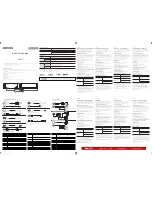
Start Up
UNT-SVX041D-EN
65
bypass mode. In occupied bypass mode, the controller
controls the space temperature based on the occupied
heating or cooling setpoints. The occupied bypass time,
which resides in the controller and defines the duration of
the override, is configurable from 0 to 240 minutes (default
value of 120 minutes). When the occupied bypass time
expires, the unit transitions from occupied bypass mode
to unoccupied mode. Pushing the
CANCEL
button
cancels the timed override request. In addition, it will end
the timed override before the occupied bypass time has
expired and transition the unit from occupied bypass
mode to unoccupied mode.
If the controller is in any mode other than unoccupied
mode when the
ON
button is pressed, the controller still
starts the occupied bypass timer without changing to
occupied bypass mode. If the controller is placed in
unoccupied mode before the occupied bypass timer
expires, the controller is placed into occupied bypass
mode and remains in this mode until either the
CANCEL
button is pressed on the Trane zone sensor or the occupied
bypass time expires.
Zone Temperature Control
The controller has three methods of zone temperature
control:
•
Cascade zone control
—used in the occupied,
occupied bypass, and occupied standby modes. It
maintains zone temperature by controlling the
discharge air temperature to control the zone
temperature. The controller uses the difference
between the measured zone temperature and the
active zone temperature setpoint to produce a
discharge air temperature setpoint. The controller
compares the discharge air temperature setpoint with
the discharge air temperature and calculates a unit
heating/cooling capacity accordingly (refer to the
illustration below). The end devices (outdoor air
damper, valves, and so on) operate in sequence based
on the unit heating/cooling capacity (0–100 percent).
If the discharge air temperature falls below the
discharge air temperature low limit setpoint,
(configurable using the Tracer® TU service tool), and
the cooling capacity is at a minimum, the available
heating capacity is used to raise the discharge air
temperature to the low limit (refer to the following
section, “Discharge Air Tempering Control”).
•
Simplified zone control
— if discharge air
temperature failure occurs, then simplified zone
controls runs. In the unoccupied mode, the controller
maintains the zone temperature by calculating the
required heating or cooling capacity (0–100%)
according to the measured zone temperature and the
active zone temperature setpoint. The active zone
temperature setpoint is determined by the current
operating modes, which include occupancy and heat/
cool modes.
•
Discharge air temperature control
— is the backup
mode that runs
only
if there is not valid zone
temperature. In this mode, the active space
temperature setpoint is used as the discharge air
temperature setpoint.
Important:
This is not a normal operating mode. The
source of the invalid zone temperature
needs to be corrected to restore normal
operation.
Discharge Air Tempering
If the controller is in cooling mode, cascade zone control
initiates a discharge air tempering function when:
•
The discharge air temperature falls below the
discharge air temperature low limit setpoint
(configurable using the Tracer® TU service tool)
•
All cooling capacity is at a minimum. The discharge air
tempering function allows the controller to provide
heating capacity (if available) to raise the discharge air
temperature to the discharge air temperature low limit
setpoint.
•
The cold outdoor air is brought in through the outdoor
air damper and when the damper is at (high) minimum
position. This causes the discharge air temperature to
fall below the discharge air temperature low limit
setpoint.
Heating or Cooling Mode
The heating or cooling mode can be determined in one of
two ways:
•
By a communicated signal from a BAS or a peer
controller
•
Automatically, as determined by the controller
A communicated heating signal permits the controller to
only
heat and a communicated cooling signal permits the
controller to
only
cool. A communicated auto signal
allows the controller to automatically change from heating
to cooling and vice versa.
In heating or cooling mode, the controller maintains the
zone temperature based on the active heating setpoint and
the active cooling setpoint, respectively. The active
heating and cooling setpoints are determined by the
occupancy mode of the controller.
For 2-pipe and 4-pipe changeover units, normal heat/cool
operation
will not
begin until the ability to conduct the
Figure 58.
Cascade zone control
Active zone
temperature
setpoint
Calculated
discharge air
temperature
setpoint
Calculated unit
heating/cooling
capacity
Measured
zone
temperature
Measured
discharge air
temperature
Difference
Difference
















































